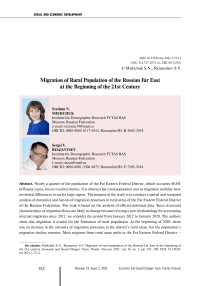Migration of rural population of the Russian Far East at the beginning of the 21st century
Автор: Mishchuk Svetlana N., Ryazantsev Sergei V.
Журнал: Economic and Social Changes: Facts, Trends, Forecast @volnc-esc-en
Рубрика: Social and economic development
Статья в выпуске: 3 т.14, 2021 года.
Бесплатный доступ
Nearly a quarter of the population of the Far Eastern Federal District, which occupies 40.6% of Russia's area, lives in rural territories. It is obvious that rural population and its migration mobility have territorial differences in such a large region. The purpose of the study is to conduct a spatial and temporal analysis of dynamics and factors of migration processes in rural areas of the Far Eastern Federal District of the Russian Federation. The work is based on the analysis of official statistical data. Since structural characteristics of migration flows are likely to change because of using a new methodology for accounting internal migration since 2011, we consider the period from January 2012 to January 2020. The authors show that migration is crucial for the formation of rural population. At the beginning of 2020, there was an increase in the intensity of migration processes in the district's rural areas, but the population's migration decline remains. Most migrants from rural areas settle in the Far Eastern Federal District - often, in towns. The flow of migrants from the town to the village retains statistical significance but does not correspond to the territorial structure of the migration outflow of rural residents. Based on the ratio of migration and natural population decline (growth), the authors developed a classification of rural areas in the subjects of the Far Eastern Federal District for 2011 and 2019. We analyze the reasons for the arrival and departure of rural population. Most migrants arrive after a temporary absence and leave for personal and family reasons. The authors show the influence of the dynamics of migration processes on the development of rural areas and agriculture in the context of a shortage of labor resources and restrictions on international movements of labor immigrants using a case study of the border region.
Rural population, rural area, migration, rural typology, migration components, migration coefficients, far east
Короткий адрес: https://sciup.org/147235410
IDR: 147235410 | УДК: 314.727.2(571.6) | DOI: 10.15838/esc.2021.3.75.11
Текст научной статьи Migration of rural population of the Russian Far East at the beginning of the 21st century
Modern rural areas are heterogeneous, and some territories may have their own peculiarities of economic and socio-cultural development. The Far Eastern Federal District of the Russian Federation (FEFD) is characterized by the differentiation of regions by economic, social, cultural, and other indicators, which is reflected in the characteristics of rural population and rural territory.
As of early 2020, nearly 25% of the total population of the FEFD lived in rural areas, which was about 6% of Russia’ s rural population. Migration processes in the Far East (FE) from 1991 to 2019 were studied in detail in the works of researchers, but the assessment was carried out without the division into urban and rural populations in most cases [1; 2; 3]. Often, the features of rural areas are explored within allRussian studies. For example, rural migration and rural areas were analyzed in detail in the works of N.V. Zubarevich, A.I. Alekseev, S.G. Safronov, S.Ya. Suschego [4; 5; 6] within all-Russian and regional studies from the point of view of geodemographic dynamics of rural population and the transformation of rural settlement; distribution of labor resources in rural areas was presented in the work of T.G. Nefedova, N.V. Mkrtchyan [7]. The collective work [8] and the research by Jiayi Zhou [9], A. Hostman, etc. [10] are devoted to the influence of foreign labor migrants and investments on the development of rural areas. The typology of rural areas is presented by N.V. Zubarevich [4], D.O. Egorova, V.S. Shurupina [11], etc. In these works, as in most others, rural population and rural areas of the Far East were not distinguished as a separate research object. For the Far East, international labor migration has been a significant phenomenon over the past few decades. The study of migration flows from China to the Russian Far East is one of the most popular areas of scientific research among specialists considering migration in this region. This question was addressed not only by Russian, but also by foreign researchers [9; 12].
If we talk about current global trends in the study of rural areas and rural population, we can note an increase in attention to socio-economic factors (low standard of living among rural population, poverty, low availability of social services, high unemployment in rural areas), which are significant conditions for the departure of rural population to urban areas [13 – 16]. Significant pushing factors are the lack of land plots among rural residents or their insignificant area, low land fertility, expansion of agricultural land areas among large tenants [17; 18; 19]. The studies emphasize the important role of education in reducing the level of migration from rural to urban areas [20; 21; 22].
In current foreign empirical studies, much attention is paid to the study of return migration from a city to a village [23], which serves as an opportunity for the development of rural areas. The main reasons and advantages of returning migrants to rural areas may relate to wider employment opportunities for young people, who have received an education [22], equalization of the standard of living between the city and the countryside, which reduces the attractiveness of living in the city [23]. In the current conditions and restrictions associated with the spread of the COVID-19 virus, the share of returning migrants from rural areas may increase. In China, the idea of the probability of return migration to rural areas and the need to use this opportunity to consolidate the rural population was voiced in the spring of 20201.
It should be noted that most studies on rural areas and rural population in the Russian Far East are local, affecting individual subjects or different time periods, which does not allow them to be compared to assess the whole situation in the FEFD. For example, the problem of reproduction of the personnel issue in agriculture was studied in the works of E.V. Koryakina, E.N. Tuzhilina, G.I. Dayanova, L.D. Protopopova, I.K. Egorova, etc. [24; 25]; N.P. Kuzmich explored the possibilities of increasing the role of socially-oriented areas of rural development in the Amur Region [26]; features of rural-urban migration in the Republic of Sakha (Yakutia) were shown by S.A. Sukneva, A.V. Trubina [27]; prospects for the development of entrepreneurship in rural areas of the Primorsky Krai were explored by E.G. Gusev and G.I. Shuman [28].
The purpose of our work is to conduct a spatial and temporal analysis of the dynamics of migration processes in rural areas of the Far Eastern Federal District of the Russian Federation and its subjects, as well as to assess the role of migration as an important component of changes in rural popu- lation. Considering a probability of transformation of structural characteristics of migration flows because of using the new methodology for accounting for internal migration, which has been active since 2011 [29], we analyze most statistical data for the period from January 2012 to January 2020.
Methods and research methodology
Considering the variety of approaches to the definition of population migration, the paper considers a part of the permanent migration of rural population, which is a set of territorial movements between a village and a city, a city and a village, a village and a village, accompanied by a change of residence for a relatively long period [30, p. 17]. This approach is explained by the usage of statistical data that do not allow taking into account seasonal migration, pendulum trips of population, travel, tourism. According to the demographic approach, migration not only affects changes in demographic development, but also reflects economic, political, geographical, and other aspects of the development of society. The first part of the study evaluates the change in the rural population by components, including natural and migration movement, as well as the role of migration and territorial transformations. The second part presents the results of the analysis of the migration movement of population in relation to irrevocable migration, based on the existing methodological apparatus used as part of the methodological approach to the study of migration processes [31, p. 281]. The analysis of the size and volume of migration flows, intensity of migration flows for the period from 2010 to 2019 was carried out, main directions of migration were identified, migration behavior was analyzed in the context of population migration factors. In addition, based on a comparative analysis of data obtained on the dynamics of natural and migration growth of rural population, a classification of the subjects of the FEFD according to the data for 2011 and 2019 is proposed.
The analysis of migration processes was carried out at the federal and regional levels. A detailed analysis of migration processes in rural areas at the local level is not presented in the article, but the work on collecting statistical data at the local level has revealed some methodological difficulties. In the database “Indicators of Municipalities”, information is aggregated by municipal districts, municipal districts, urban districts, urban and rural settlements, intersettlement territories, which corresponds to Federal Law no. 131-FZ “On general principles of the organization of local self-government in the Russian Federation”, dated October 6, 2003 (as amended on May 1, 2019, no. 87-FZ). This division does not fully correspond to the assessment of the flows of rural and urban population, because, as a result of changes taking place in the administrative-territorial system, part of rural population does not live in rural settlements, and it is invisible for the analysis of the migration of rural population. The percentage of unaccounted rural residents varies by region. While comparing statistical data on a number of rural residents in the FEFD2 and a number of people living in rural settlements3, it turned out that, at the beginning of 2020, a number of rural population in the district was 14.1% higher than a number of people living in rural settlements. For individual subjects, this ratio reaches 100% (Sakhalin and Magadan regions), 36.7% in Primorsky Krai, 35.2% in Chukotka AO, 13.1% in Jewish AO. Such differences in indicators distort information about the settlement of rural population since this part of rural population is located outside rural settlements. In addition, when analyzing migration flows of rural population (intraregional, interregional, international) within the administrative-territorial units, movements of the specified share of the rural population will not be considered.
We use a systematic approach, a generalization method, a cartographic method, an analysis of statistical, literary, and empirical data on the dynamics of migration processes in rural areas of the Russian Far East.
Research results
General characteristics of rural population of the Far Eastern Federal District
The share of rural population in the FEFD is about a quarter of total population of the district. As a result of the inclusion of two subjects into the Far Eastern Federal District in November 2018 – Republic of Buryatia and Zabaykalsky Krai – this indicator increased by 2.87 p.p. At the beginning of 2020, rural population of the FEFD was 5.9% of the total rural population in Russia.
Dynamics of changes in the characteristics of rural population of the FEFD, in comparison with other districts of the Russian Federation for the period from 2011 to 2020, does not differ from a general situation. The analysis of data on nine subjects of the FEFD at the beginning of 2018 and eleven subjects at the beginning of 2020 indicates the preservation of the seventh rank of the FEFD according to the indicator “average age of rural population”. In absolute terms, growth for this indicator was 0.09 years.
As of early 2020, the FEFD ranked 4th in terms of the share of rural population among the total population. Absolute values of this indicator for the district increased from 24.25 to 27.1% from 2018 to 2020.
The number of residents of disabled age per 1000 residents of working age has changed significantly. In early 2011, the FEFD occupied the last (8th) place among federal districts by this indicator, then, at the beginning of 2018, it was at the 7th position. In early 2020, with 11 constituent entities, the FEFD ranked 5th among
Table 1. Ranking of federal districts of the Russian Federation by indicators of rural development at the beginning of 2012, 2018, and 2020
|
Indicator |
Year |
RF |
CFD |
NWFD |
SouFD |
NCFD |
VFD |
UFD |
SFD |
FEFD |
|
Share of rural population in the total population of the region, % |
2012 |
26,1 |
18,4 |
16,3 |
37,5 |
50,8 |
28,9 |
19,8 |
27,8 |
25,1 |
|
rank |
7 |
8 |
2 |
1 |
3 |
6 |
4 |
5 |
||
|
2018 |
25,6 |
17,8 |
15,6 |
37,4 |
50,2 |
28,1 |
18,6 |
26,9 |
24,2 |
|
|
rank |
7 |
8 |
2 |
1 |
3 |
6 |
4 |
5 |
||
|
2020 |
25,3 |
17,7 |
15,1 |
37,2 |
49,7 |
27,8 |
18,4 |
25,7 |
27,1 |
|
|
rank |
7 |
8 |
2 |
1 |
3 |
6 |
5 |
4 |
||
|
Average age of population, years |
2012 |
38,96 |
42,21 |
41,08 |
39,32 |
32,65 |
40,27 |
38,70 |
37,87 |
36,23 |
|
rank |
1 |
2 |
4 |
8 |
3 |
5 |
6 |
7 |
||
|
2018 |
39,92 |
42,98 |
42,1 |
40,37 |
33,77 |
41,45 |
39,54 |
38,61 |
37,39 |
|
|
rank |
1 |
2 |
4 |
8 |
3 |
5 |
6 |
7 |
||
|
2020 |
40,41 |
43,38 |
42,48 |
40,89 |
34,35 |
42,05 |
40,02 |
39,45 |
37,48 |
|
|
rank |
1 |
2 |
4 |
8 |
3 |
5 |
6 |
7 |
||
|
Number of nonworking people per 1 thousand residents of working age, people. |
2012 |
713 |
731 |
693 |
708 |
685 |
725 |
719 |
726 |
655 |
|
rank |
1 |
6 |
5 |
7 |
3 |
4 |
2 |
8 |
||
|
2018 |
864 |
859 |
869 |
846 |
768 |
886 |
927 |
932 |
830 |
|
|
rank |
5 |
4 |
6 |
8 |
3 |
2 |
1 |
7 |
||
|
2020 |
846 |
835 |
849 |
828 |
751 |
876 |
913 |
921 |
836 |
|
|
rank |
6 |
4 |
7 |
8 |
3 |
2 |
1 |
5 |
||
|
Women per 100 men, people |
2012 |
1090 |
1133 |
1076 |
1103 |
1079 |
1087 |
1085 |
1076 |
990 |
|
rank |
1 |
6 |
2 |
5 |
3 |
4 |
6 |
7 |
||
|
2018 |
1073 |
1108 |
1054 |
1099 |
1067 |
1061 |
1069 |
1060 |
984 |
|
|
rank |
1 |
7 |
2 |
4 |
5 |
3 |
6 |
8 |
||
|
2020 |
1068 |
1099 |
1046 |
1095 |
1063 |
1054 |
1064 |
1063 |
991 |
|
|
rank |
1 |
6 |
2 |
4 |
5 |
3 |
4 |
7 |
Note: the higher the value of the indicator, the higher the rank is.
Complied according to: Number and Migration of the RF Population. Available at:
federal districts, which shows an increase in the demographic burden on its working-age population (Tab. 1) .
Inclusion of the Republic of Buryatia and Zabaykalsky Krai into the FEFD ensured an increase in the district’s rural population by nearly 740 thousand people at the beginning of 2019, urban population – by 1310 thousand people. However, in the early 2020, the population has decreased.
In the context of the FEFD subjects in the early 2020, as of at the beginning of 2012, a maximum number of rural residents lived in Primorsky Krai (19.4% of the total number of rural residents in the FEFD). The second place was previously occupied by the Republic of Sakha (Yakutia), but, after 2018, the second place was taken by the Republic of Buryatia (18.2% of rural residents from the indicators for the FEFD in the early 2020). In five FEFD subjects in 2019, the share of the rural population in the total population of the region exceeded 30% (Republic of Sakha (Yakutia), Amur Oblast, Jewish AO, Republic of Buryatia, and Zabaykalsky Krai). The Republic of Buryatia is the leader according to the number of rural residents per 1000 citizens and the share of rural residents (40.8%). A minimum share of rural population in a region’s total population was noted in the Magadan Oblast (3.93% in 2019).
Components of rural population change
Three components are considered in the formation of rural population: migration processes, natural movement of population, and municipalterritorial transformations (MTP).
Figure 1. Components of change of a number of permanent rural population of the FEFD for 2008–2019, people
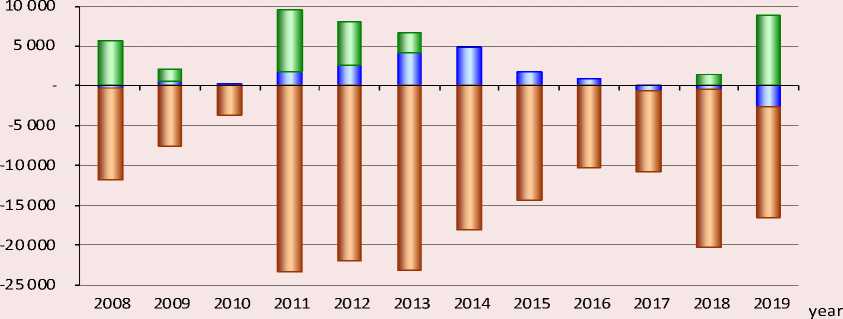
□ natural growth □ migration growth □ МТP
Complied according to: Number and Migration of the RF Population. Available at: document/13283
The change of a number of rural population depends on the dynamics of population’s natural movement to a lesser extent than the urban one (Fig. 1) .
Natural growth does not compensate for negative values of migration processes. For the period from 2008 to 2019, total natural increase in the rural population of the Far East amounted to 12.8 thousand people, while the migration decline was 178 thousand people. In some years, an increase in the number of rural population is recorded within the framework of the MTP.
The analysis of migration in the FEFD is complicated by changes in the statistical accounting of migrants in 2011 and the expansion of the territorial borders of the district, which occurred in November 2018. Changes in the statistical accounting of migration led to a more significant increase in indicators in urban areas in 2011 compared to 2010. Territorial changes affected the indicators of rural areas (Fig. 2) .
Considering the directions of migration, we note that, in the context of federal districts, the main flow of migrants is concentrated within the Far East itself. 86% of rural migrants move within the FEFD, and only 14% leave the district. In 2019, about 28% of rural areas moved to a similar type of settlement. The share of migrants departuring and arriving in rural areas in 2019 was 8.9% of the total number of migrants in the district, or 28% of the number of migrants leaving rural areas.
Almost three quarters of migrants from rural areas leave for cities of the FEFD. At the same time, there is a reverse flow of migrants from the urban area of the district to the rural area, which compensated for the migration outflow of rural residents in 2019 by 88.8%. It should be noted that these indicators may not indicate the absence of problems of rural population “washing”. Probably, migrants from urban areas move to the suburbs that have the status of rural areas, where the infrastructure and quality of life are inferior to the urban level, but much better than in the rural hinterland. In addition, services and tariffs in rural areas are lower than urban ones, which motivates population to move from cities to rural suburbs.
Departure ratio
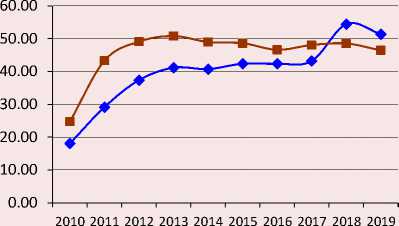
Figure 2. Migration coefficients in rural and urban areas of the FEFD, 2010–2019, per 1,000 people
Arrival rate
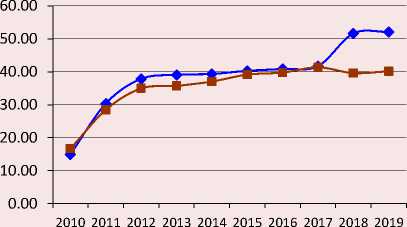
Coefficient of migration turnover intensity
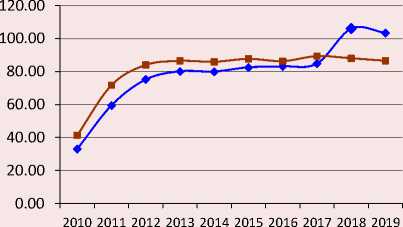
Migration growth rate
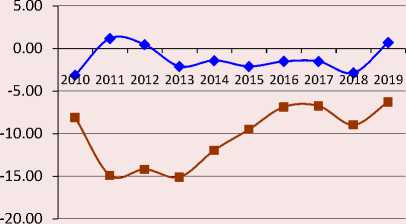
Relative migration balance
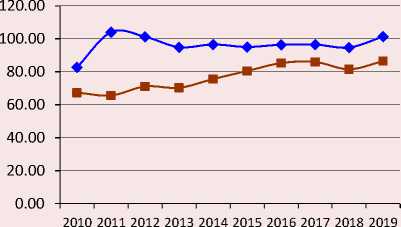
Migration efficiency coefficient
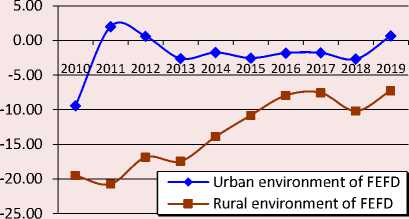
Complied according to: Number and Migration of the RF Population. Available at: document/13283
The second direction of migration from rural areas of the FEFD is the Siberian Federal District, whose share in 2019 was 4.4% (4.6% in 2013) of the number of Far Eastern rural migrants who left for rural areas. The third and fourth places are occupied by the Southern and Central Federal Districts (3.3
and 2.2%). The share of other federal districts is insignificant.
Thus, despite the increase in the flow of migrants from rural areas, most of them currently settle in the subjects of the FEFD – in urban areas mainly. The flow of migrants from a city to a
Table 2. Volume of municipal-territorial transformations in rural areas of the Far East, people
2008 2009 2012 2013 2018 2019 Total, 2008–2019 FEFD 5683 1478 5436 2451 1359 8933 25340 Primorsky Krai - - - 60 - 2820 2880 Amur Oblast 861 1478 791 1400 - - 4530 Magadan Oblast - - - 991 - 268 1259 Khabarovsk Krai - - 2551 - 1359 - 3910 Kamchatka Krai 4167 - 2094 - - - 6261 Republic of Sakha (Yakutia) 655 - - - - - 655 Republic of Buryatia* 1453 -15353 - 4189 - - 0** Zabaykalsky Krai* 1067 - - - - 5845 5845** Note. The table includes FE subjects and years, where and when MTT happened in the studied period. * Subject was not a part of the FEFD until 2017. ** Total for 2018–2019 – during the period of joining the FEFD. Complied according to: Number and Migration of the RF Population. Available at:
village retains its statistical significance but does not correspond to the territorial structure of rural residents’ migration outflow.
In 2019, positive values of most coefficients were largely explained not by the improvement of the migration situation, but by indicators of municipal and territorial transformations, the volume of which amounted to nearly 9 thousand people. In some years, the MTT had a significant impact on the dynamics of rural population. In the period from 2008 to 2019 in the Far East (considering data for two new subjects in 2018 and 2019), the growth of rural population due to the MTT amounted to 25.3 thousand people.
In regional terms, from 2008 to 2019, most MTT have occurred in the Amur Oblast (2008, 2009, 2012, 2013), however, a maximum increase in a number of rural residents at the expense of MTT was observed in Kamchatka Krai (+6261 people) (Tab. 2) .
In 2019, Zabaykalsky Krai was the only region with a total increase in rural population (+624), MTT provided an increase in rural population by 5,845 people, which exceeded natural and migration decline of population by 12%. In Primorsky Krai and the Magadan Oblast, the volume of MTT did not compensate for the natural and migration decline of the population, a number of rural population in these regions decreased.
Intensity of migration processes
The analysis of relative migration indicators in rural areas by the subjects of the FEFD from 2011 to 2019 indicates a positive trend. The intensity of migration turnover in rural areas in 2019, compared to 2011, increased in all subjects of the FEFD, except for Jewish AO (JAO). In Chukotka AO, the highest growth of the indicator was noted during the studied period (by 2.5 times). In 2019, a maximum value of the intensity coefficient of migration turnover was recorded in the Magadan Oblast, a minimum value – in Zabaykalsky Krai.
The growth of the intensity indicator of migration turnover is associated with the positive dynamics of the values of the arrival and departure coefficients (Tab. 3) . In all subjects of the FEFD in 2019, there was an increase in the value of the arrival coefficient, compared to the level of 2011. A maximum growth rate of the coefficient was recorded in Chukotka AO (3.6 times). Minimum arrival values were registered in Khabarovsk Krai (the growth rate is 11.6%). The growth rate of the departure values is lower than arrival indicators, which indicates a stabilization of the situation and a decrease in the number of people leaving the region. A decrease in the departure value in 2019 to the level of 2011 was recorded in four subjects (JAO, Amur and Sakhalin oblasts, Zabaykalsky Krai). The highest rates of departure growth are
Table 3. Indicators of migration in rural areas by subjects of FEFD, 2011, 2019
|
Indicator |
Year |
GO ^ S |
1 s 03 ^ |
§ "2 E ^ |
E « |
о |
o S |
о "су |
о |
о |
о -^ |
§^ 03 1X1 |
|
DC |
2011 |
39.4 |
33.1 |
44.9 |
43.4 |
43.3 |
93.0 |
53.2 |
46.9 |
35.4 |
42.5 |
38.8 |
|
2019 |
41.3 |
50.4 |
51.7 |
52.4 |
41.0 |
107.3 |
48.0 |
31.5 |
63.4 |
51.9 |
37.4 |
|
|
growth rates |
4.8 |
52.4 |
15.1 |
20.7 |
-5.3 |
15.4 |
-9.8 |
-32.8 |
79.1 |
22.0 |
-3.7 |
|
|
AC |
2011 |
14.9 |
27.0 |
30.9 |
41.0 |
31.1 |
34.2 |
28.9 |
27.8 |
11.0 |
28.7 |
17.8 |
|
2019 |
33.9 |
46.2 |
47.9 |
45.8 |
35.6 |
61.5 |
43.2 |
30.1 |
51.3 |
49.3 |
23.6 |
|
|
growth rates |
128.2 |
71.1 |
55.2 |
11.6 |
14.4 |
80.1 |
49.4 |
8.4 |
364.5 |
71.6 |
32.5 |
|
|
MG |
2011 |
-24.6 |
-6.1 |
-14.0 |
-2.4 |
-12.2 |
-58.8 |
-24.3 |
-19.1 |
-24.3 |
-13.8 |
-21.0 |
|
2019 |
-7.4 |
-4.2 |
-3.7 |
-6.6 |
-5.4 |
-45.8 |
-4.8 |
-1.4 |
-12.1 |
-2.6 |
-13.8 |
|
|
growth rates |
69.9 |
30.9 |
73.4 |
-179.1 |
55.7 |
22.2 |
80.2 |
92.8 |
50.3 |
81.1 |
34.4 |
Complied according to: Number and Migration of the RF Population. Available at:
Population of the Russian Federation by Municipality. Available at:
typical for Chukotka AO and Kamchatka Krai (79.1 and 52.4, respectively). The migration increase in all subjects of the district retains negative values. Based on the indicators of migration growth coefficients in rural areas in 2011 and 2019, all subjects of the FEFD were divided into three groups: with a high, medium, and low level of migration growth coefficient. Considering the preservation of negative coefficient values, we would like to note that the closer the value to zero, the better the situation is (the first type of regions with a high coefficient value), and vice versa – the greater the negative coefficient value, the lower the level of migration growth in the region is (the third type of regions with a low coefficient value). The second type is characterized by an average value of the coefficient. In 2011 and 2019, the Magadan Oblast was characterized by a low migration increase, having maximum negative values of the coefficient. The second group with the average values of the migration growth coefficient in 2011 included the Republic of Sakha (Yakutia), the Sakhalin Oblast and the Chukotka AO. In 2019, these three regions moved to the group with a high coefficient value. Thus, in 2019, only the Magadan
Oblast was included in the group with a low coefficient value, having not changed its position since 2011, the remaining 10 subjects of the FEFD were in the group with a high coefficient value, that is, the migration situation was improving.
Classification of the subjects of the FEFD according to the dynamics of natural and migration growth in rural areas
According to the model of J. Webb [32], based on the ratio of natural and migration growth (loss) of population, 8 types of regions can be distinguished. As a result of the application of this classification for rural areas of the FEFD in 2011 and 2019, three types were identified. In 2011, two types of regions were identified: type 1, where the migration loss is higher than the natural increase, and type 2, where the migration loss is higher than the natural loss.
In 2019, the third type was determined, in which the value of the migration loss is lower than the indicator of the natural population loss that is associated, on the one hand, with a significant reduction in the migration loss of the population and, on the other, with the preservation or slight deterioration of natural loss indicators.
Figure 3. Classification of the FEFD subjects according to the migration and natural dynamics of rural population, 2011 and 2019
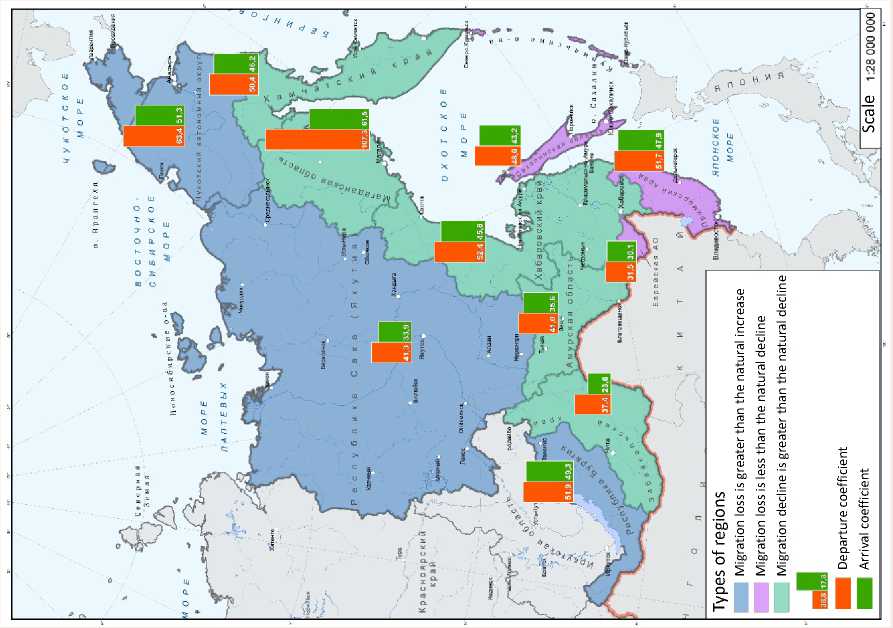
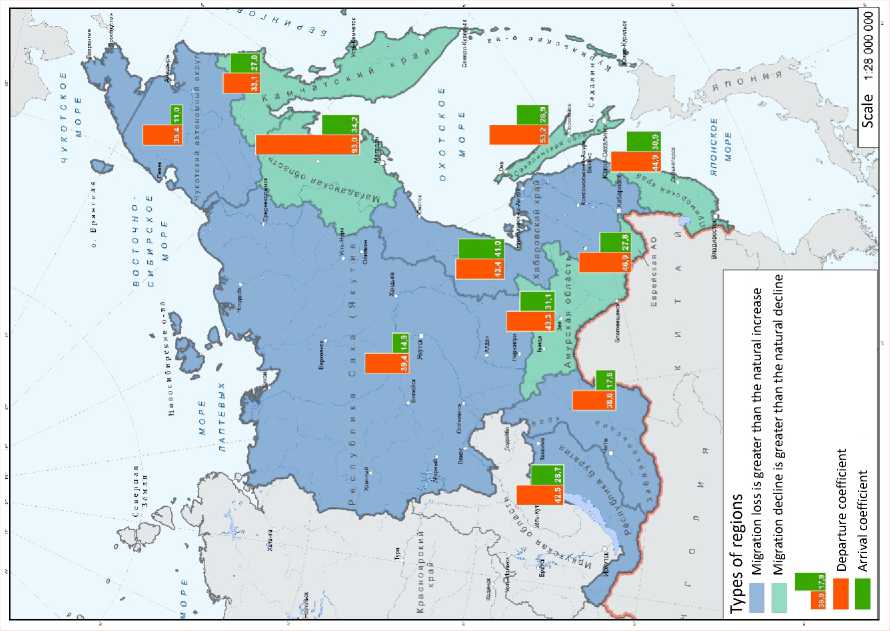
The designated types were named (Yakut, Magadan, Sakhalin) based on the prevalence of the designated processes in certain regions of the Far East. A typical region of the first type is the Republic of Sakha (Yakutia) with still a positive natural population growth with negative migration values. By 2019, the number of regions of this type had decreased due to the formation of a natural population decline in them. It is designated as “Yakut”.
The second type of subjects (“Magadan”) is characterized by an excess of the migration loss of population over the natural loss. The Magadan Oblast is a striking example of this type since high values of migration loss of the population remained there during the studied decade.
The third type (“Sakhalin”) was formed because of a decrease in the migration loss of population while maintaining stable values of natural loss. This type of region is also characterized by a “double” population decline, including migration and natural processes, while the main reason for the population decline is natural decline. This ratio of indicators was more often observed in the Sakhalin Oblast. The classification of the subjects of the FEFD according to the dynamics of demographic indicators in 2011 and 2019 is shown in figure 3 .
Thus, in some regions of the FEFD, the migration decline of population is drying up while the natural decline remains. Let us emphasize that we are talking about rural areas, where the birth rate has traditionally been high. For example, in 1990, 18.7 births per 1000 rural residents and 14.4 births per 1000 urban residents were registered in the regions of the Far East as a whole. This indicator decreased to 11.9 and 9.8, respectively, in 2019. The decrease in the number of births in rural areas was 36.4%, in urban areas – 25%.
Migration reasons
As we noted earlier, the main share of rural migrants moves within the framework of the FE. Based on the statistical approach, the paper analyzes the motives of migration of the Far East rural population in 2019.
Attention is drawn to a high share of population with the reason “return after temporary absence”. It should be recalled that, since 2011, statistical accounting for long-term migration of the population includes people registered at the place of stay for a period of 9 months or more, as well as people removed from the registration at the place of stay due to the end of their stay period. In this case, the registration account removal is carried out automatically. It is not possible to determine true causes of population migration with the indication “return after temporary absence” and classify them by economic, social, and other factors.
In general, for the Far East in 2019, 17% of retired rural population are automatically accounted for due to “return after temporary absence”, 37% – among newly arrived rural population. Considering that the probability of the very fact of migration of the population due to this cause is low, it can be assumed that the flow of migrants arriving in rural areas is lower than the values indicated in official statistical sources.
Among other migration reasons of the rural population, the share of people who changed their place of residence due to study, work, and personal reasons is significant.
Significance of these reasons in the flows of incoming and outgoing migrants is not identical (Fig. 4) . Migrants leave (in descending order) for personal and family reasons, due to return after temporary absence, other reasons (most often, these are reasons for purchasing housing) and due to work. Nearly 80% of migrants who leave due to return after a temporary absence move within Russia. Among the foreign countries where migrants go, there are Uzbekistan (15.6%), Ukraine (15%), Armenia and Tajikistan (12.4% each), Kyrgyzstan (11.1%).
In the context of the Far East regions, the highest values of the share of departing migrants due to return after temporary absence (more than 30% of a total number of migrants who indicated the reasons) are recorded in the Kamchatka Krai and
Figure 4. Distribution of migrants in rural areas of FEFD according to the circumstances that caused the change of residence, 2019, %
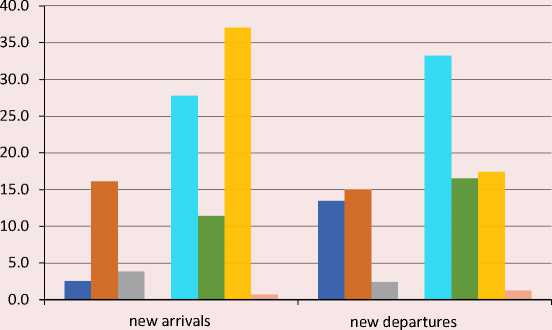
-
■ study
-
■ work
-
■ return to a previous place of residence
-
■ aggravation of internatinal relations
-
■ personal, family problems
-
■ other reasons
-
■ return after temporary absence
-
■ reason in not mentioned
Compiled according to: Rosstat data.
the Sakhalin Oblast. In addition, the Kamchatka Krai is the only region where the share of this category of migrants from Russia is below 50% of a total number of migrants, international migrants accounted for 54.4%, including ones from the CIS countries – 97.8%. The countries of departure are Armenia (34% of a total number of migrants from the CIS), Kyrgyzstan (31%), and Uzbekistan (13%). It should be recorded that Kamchatka Krai differs from other Far Eastern regions by a high proportion of international migrants from the CIS countries. In the Sakhalin Oblast, the share of internal Russian migrants returning after a temporary absence was 76.1%, 25% left for Ukraine as part of international migration, and 18.4% went to Tajikistan.
The maximum share of migrants who have left due to work is registered in Chukotka AO and Kamchatka Krai (100% within Russia).
Among the migrants who arrived in the rural area of the FEFD, a primary reason is “automatic registration of migrants” among those who returned after a temporary absence. The second most-popular reason is personal or family causes. A territorial analysis of the flows of migrants who arrived “after a temporary absence” showed that more than 50% are intraregional migrations in 7 out of 11 subjects. Minimum values of intraregional migration were recorded in the JAO (29%), the share of migrants from the Khabarovsk Krai in it was 41%. This situation is explained by a high share of the region’s population traveling to work in the neighboring Khabarovsk Krai.
Regarding a number of migrants who arrived due to work, the Sakhalin Oblast leads according to the share of international migrants (53.3%), which is explained by the involvement of a large number of specialists from abroad to work in oil and gas industries. In other subjects of the district, the share of international migrants is significantly lower than 50%, it reaches its maximum value in Chukotka AO (5.1%).
Minimum values of intraregional movements of Russian citizens in relation to work were noted in Chukotka AO (15%), which reflects a predominant number of labor migrants arriving from other regions of Russia. A similar situation has developed in the Sakhalin Oblast, Kamchatka Krai, and Magadan Oblast (28, 28, and 34% of intraregional migrants). Attention is drawn to high values of intraregional migration in relation to work in the Republic of Sakha (Yakutia) – 92%. This may be caused by differences in the level of economic development of the Republic’s regions.
Discussion
As an important condition for solving managerial tasks to regulate (or attempt to regulate) migration activity of population, we can consider the presence of a more correct and accurate assessment of the causes of population’s migration.
To understand the migration process, it is necessary to know what makes a person strive for resettlement and what are the necessary conditions for this [33, p. 102]. In our opinion, V.V. Onikienko and V.A. Popovkin’s point of view, expressed in 1973, is still relevant: “Dissatisfaction with the rural way of life remains important in the migration of rural population: conditions of agricultural labor and isolation from achievements of modern civilization, which strengthens as a result of the expansion of means of communication” [34, p. 11].
Paraphrasing the thesis of T.I. Zaslavskaya and L.P. Lyashenko about the intentions of population to leave, we note that a decision to leave or stay in a settlement is closely “related to the opinion of people about what awaits them in the future (whether it would “develop”, “stand still”, or be “liquidated”) [35, p. 45]. That is, the orientation to migration is not a “direct” response to external conditions, but it acts as a “subjective refraction of external factors in the direct experience of an individual” [30, p. 163].
In the second decade of the 21st century, the intensity of the population outflow from the Far East decreased, but it is likely that a number of settlements with a few inhabitants and their concentration in cities or in closely located territories will continue to decline [4]. Moreover, we can highlight the possibility of creating or restoring settlements that act as a place of residence for employees of projects implemented within the territories of advanced socio-economic development (TAD). As a result, the economic factor can have a positive impact on migration processes in rural areas. However, it is more likely that we can talk about the formation of an influx of labor migrants than permanent population.
At the same time, all-Russian trends, expressed in the direct relationship of the migration outflow with the sparseness of the territory’s settlement [36], are likely to persist in rural areas of the FEFD.
Despite regional peculiarities, the reasons for migration from rural areas of the FEFD coincide with the reasons in the European regions of the country [37]. A low level and quality of life of population inferior to urban indicators, lack of infrastructure, limited opportunities for education and cultural development of population, employment opportunities with a corresponding income are the main migration factors [38; 39]. In sociological surveys, rural residents of the Republic of Buryatia mention low standard of living and social infrastructure, poor quality of educational and medical services, and a reduction in the production sector as the reasons for migration from rural areas. A similar situation is in Jewish AO [40].
Agreeing with V.I. Perevedentsev’s point of view that a number of jobs largely determines a number of residents in a locality [31, p. 102], we assume that, for the Far Eastern regions of the Russian Federation, the implementation of measures of the “Strategy of sustainable development of rural territories of the Russian Federation until 2030”, approved by the decree of the Government of the Russian Federation no. 151-r on February 2, 2015, gives hope for the consolidation of rural population and the development of rural areas. Improvement of the quality of life in rural areas of the FEFD subjects will probably reduce population’s migration outflow. At the same time, the level of development of rural areas varies in individual regions.
In most Far Eastern regions, there was a reduction of villages in the post-Soviet period. Regional authorities are working to relocate residents from officially liquidated settlements.
Each region develops its own programs to address this issue. In addition, financial support is provided at the federal level. At the same time, the Republic of Sakha (Yakutia) is one of the few regions where villages have not been liquidated. It is working on their preservation. In 2021, within the framework of the “Movement of Good Deeds” program, 1 billion rubles are provided for the development of rural areas4.
Another example of rural development reflects the result of the implementation of the “Far Eastern Hectare” program. In the Khabarovsk Krai, a new “Dalnevostochnoe” village has appeared on an area of about 200 hectares. It was formed because of the consolidation of compactly placed land plots provided under the program. The village is a part of an active rural settlement with an old school and without UCC: these issues are currently being discussed. It is obvious that, to secure residents in this rural settlement, it is necessary to improve the level of educational and medical services 5 .
We assume that projects on the territories of advanced socio-economic development can have a positive impact on the development of rural areas. Since 2015, 20 TADs have been registered in the district’s regions, within which projects in industry and agriculture, logistics, etc. have been announced. The projects are implemented in urban and rural areas. At the same time, it is necessary to consider the experience of the European regions of Russia, which has shown that the work of agricultural holdings in rural areas often leads to increased polarization, fragmentation of agriculture, and an increase in the outflow of local residents from economically disadvantaged areas [41]. Since the growth of indicators of socioeconomic development of rural areas, because of the implementation of these projects in the FEFD, is not obvious, a promising direction in the study of rural areas of the macro-region will be to assess the impact of implemented projects on the indicators of rural areas and rural population.
Development of rural areas was largely related to the state of agriculture. The migration of rural population adjusts the nature of agricultural employment of the population in the FEFD. On the one hand, the same principles apply in the FEFD regions that are characteristic of the central agricultural regions: low wages remain, production is being modernized, and labor intensity in agriculture decreases [7]. On the other hand, in some Far Eastern regions, the practice of attracting international labor migrants to agriculture is widespread, which solves the problems of labor shortage and reduction of economic costs but can worsen the situation in rural areas [42]. In 2020, dependence of agriculture (rural areas) on the flows of international labor migration is noticeable. A striking example is Jewish AO, where the rural population continues to decline, due to migration loss too, but the acreage increases, and foreign investors are ready to finance their agricultural projects. In 2020, it was planned to attract about 1.3 thousand labor migrants from China for spring field work in the JAO. Due to the quarantine, quotas for attracting foreign labor were not in demand. A possibility of replacing foreign workers with local specialists can only be partially considered.
Conclusion
Within the framework of the demographic approach, it is shown that the rural area of the FEFD is heterogeneous, and it differs in the dynamics, prerequisites, and consequences of migration processes. Despite obvious regional differences, at the beginning of 2020, the migration decline of rural population remains in the district with increased intensity of migration processes.
The study proposes and tests an approach to assessing the migration situation in the region’s rural areas, considering absolute and relative migration indicators, which allows analyzing intra-and interregional changes.
The classification of the subjects of the Russian Federation in the FEFD is developed according to the model of J. Webb based on the indicators of demographic processes, considering natural and migration growth. The formation of the third type of regions in 2019, characterized by an excess of natural population loss over migration that was not observed in 2011, was recorded.
Unlike previous studies, the work with the dynamics from 2008 to 2019 considers the factor of municipal-territorial transformation when assessing the formation of the rural population in the Far Eastern regions of the Russian Federation.
The analysis of the motives for the arrival and departure of migrants in the context of the FEFD subjects reflects regional differences in migration processes, which is associated with the population’s standard of living, specifics of the sectoral structure of the labor market, and geographical features of the studied territories.
The role of the administrative factor, changing the dynamics and directions of migration processes in rural areas within the implementation of regional and federal programs for the development of rural territories, is revealed.
As a result of the conducted research, the importance of considering the regional features of rural development in the subjects of the FEFD is shown. At the same time, it may be more effective to conduct comparative interregional studies that allow identifying common areas and differences of territories within the district. Complete information about the relationship between demographic, socio-economic characteristics, and objective data on the causes of population migration can be obtained by supplementing official statistical data with the results of questionnaire and expert surveys. At the same time, the regulation of migration should be a single process with the planning of the socio-economic development of the regions and regional differentiation of the conditions and the population’s standard of living. Otherwise, there will be a discrepancy in the development plans of the regions and directions of migration flows.
Список литературы Migration of rural population of the Russian Far East at the beginning of the 21st century
- Vashchuk A.S., Ermak G.G. The host community and labor migrants in the Russian Far East: An interdisciplinary analysis of the historical situation of the beginning of the 21st century. Regional'nye problemy=Regional Problems, 2016, vol. 19, no. 4, pp. 117–124 (in Russian).
- Vorob'yova O.D. Labour market and migration in the Far East. Uroven' zhizni naseleniya regionov Rossii=Living Standards and Quality of Life, 2017, no. 2 (204), pp. 35–40. DOI: 10.12737/article_59007e9adba372.94662480 (in Russian).
- Mishchuk S.N. General characteristics and regional differences of migration processes in the Russian Far East in the Post-Soviet period. Reg. Res. Russ, 2020, vol. 10, pp. 86–96. DOI: 10.1134/S2079970520010074
- Zubarevich N.V. Transformation of rural settlement pattern and service network in rural areas. Izvestiya RAN. Seriya geograficheskaya=Izvestiya Rossiiskoi Akademii Nauk. Seriya Geograficheskaya, 2013, no. 3, pp. 26–38 (in Russian).
- Alekseev A.I., Safronov S.G. Changes in rural settlement patterns in Russia during the late 20th – early 21st centuries. Vestnik Moskovskogo universiteta. Ser. 5. Geografiya=Moscow University Bulletin. Series 5, Geography, 2015, no. 2, pp. 66–76 (in Russian).
- Sushchii S.Ya. Rural territories of the Volgograd region: Problems of demographic development (the last third of the XX - beginning of the XXI centuries). Selo Rossii=Village of Russia, 2019, no. 2, pp. 5–28. DOI: 10.22162/2658-5987-2019-2-5-28 (in Russian).
- Nefedova T.G., Mkrtchyan N.V. Migration of rural population and dynamics of agricultural employment in the regions of Russia. Vestnik Moskovskogo universiteta. Ser. 5: Geografiya= Moscow University Bulletin. Series 5, Geography, 2017, no. 5, pp. 58–67 (in Russian).
- Gudaj R.T., Yi F., Arefeva V.A., Yanbykh R.G., Mishchuk S.N., Potenko T.A., Zhou J., Zuenko I.Yu. Chinese farmers in the Russian Far East and local rural development. The American Journal of Economics and Sociology, 2020, vol. 79, iss. 5, pp. 1511–1551. DOI: 10.1111/ajes.12365
- Jiayi Zhou Chinese agrarian capitalism in the Russian Far East. Third World Thematics: A TWQ Journal, 2016, vol. 1:5, pp. 612–632. DOI: 10.1080/23802014.2016.1327795
- Horstmann A., Saxer M., Rippa A. Routledge Handbook of Asian Borderlands, 2018. 462 p.
- Egorov D.O., Shurupina V.S. Rural settlement system of Russia: Typology of territories by rural settlements population. Regional'nye issledovaniya=Regional Studies, 2018, no. 4 (62), pp. 4–16 (in Russian).
- Horie N. The positionality of Russia’s Far East border regions. Problems of Economic Transition, 2017, vol. 59 (10), pp. 753–767. DOI: 10.1080/10611991.2017.1416835
- Chukwuedozie K. Ajaero, Patience C. Onokala. The effects of rural-urban migration on rural communities of Southeastern Nigeria. International Journal of Population Research, vol. 2013. DOI: 10.1155/2013/610193
- Wang C., Zhang Y., Yang Y., Yang Q., Hong J. What is driving the abandonment of villages in the mountains of Southeast China? Land Degrad Dev, 2019, vol. 30, pp. 1183–1192. DOI: 10.1002/ldr.3303
- Sagynbekova L. Environment, rural livelihoods, and labor migration: A case study in Central Kyrgyzstan. Mountain Research and Development, 2017, vol. 37 (4), pp. 456–463. DOI: 10.1659/MRD-JOURNAL-D-17-00029.1
- Akash Saha M.M., Adhikary S.K., Acharya Mishra G.C. Migration in Agriculture the Realm and Reality. Krishi Sanskriti Publications, 2019. 223 р.
- Shaw R.P. Land tenure and the rural exodus in Latin America. Economic Development and Cultural Change, 1974, vol. 23 (1), pp. 123–132.
- Siciliano G. Rural-urban migration and domestic land grabbing in China. Popul. Space Place, 2014, vol. 20, pp. 333–351. DOI: 10.1002/psp.1830
- Xiao W., Zhao G. Agricultural land and rural-urban migration in China: A new pattern. Land Use Policy, 2018, vol. 74, pp. 142–150. DOI: 10.1016/j.landusepol.2017.05.013
- Liu Z. Human capital externalities and rural–urban migration: Evidence from rural China. China Economic Review, 2008, vol. 19, pp. 521–535.
- Bjarnason T., Edvardsson I.R. University pathways of urban and rural migration in Iceland. Journal of Rural Studies, 2017, vol. 54, pp. 244–254. DOI: 10.1016/j.jrurstud.2017.07.001
- Buchenrieder G., Dufhues T., Möllers J., Runschke D., Sagyndykova G. Return to the countryside: The return intentions of highly educated young people in the Akmola province of Northern Kazakhstan. Population, Space and Place, 2020, vol. 26, iss. 2, pp. 1–14. DOI: 10.1002/psp.2273
- Shuangshuang Tanga, Pu Haob. The return intentions of China’s rural migrants: A study of Nanjing and Suzhou. Journal of Urban Affairs, 2019, vol. 41, no. 3, pp. 354–371. DOI: 10.1080/07352166.2017.1422981
- Dayanova G.I. et al. Reproduction of labor resources in agriculture of the Republic of Sakha (Yakutia). International Agricultural Journal, 2020, vol. 63, no. 2, pp. 67–77. DOI: 10.24411/2588-0209-2020-10152 (in Russian).
- Koryakina E.V., Tuzhilina E.N. The problem of rural cadres as the upgrading of the resource potential (for example, the south of the Far East in the years of Perestroika). Vestnik Bryanskogo gosudarstvennogo universiteta=The Bryansk State University Herald, 2017, no. 3, pp. 61–69 (in Russian).
- Kuz'mich N.P. Construction in rural areas as a basis for enhancing the role of socially oriented areas of rural development in the Amur Region. Vestnik KrasGAU=Bulletin of KrasGAU, 2011, no. 5, pp. 3–7 (in Russian).
- Sukneva S.A., Trubina A.V. The demographic component of formation juvenile potential of Republic Sakha (Yakutia). Regional'naya ekonomika: teoriya i praktika=Regional Economics: Theory and Practice, 2009, no. 32 (125), pp. 139–144 (in Russian).
- Gusev E.G., Shuman G.I. Perspective directions of development entrepreneurship in rural areas of the Primorsky kray in the new economic conditions. Fundamental'nye issledovaniya=Fundamental Research, 2016, no. 11-2, pp. 378–386 (in Russian).
- Korel' L.V. Peremeshcheniya naseleniya mezhdu gorodom i selom v usloviyakh urbanizatsii [Population Movements between Urban and Rural Areas in the Context of Urbanization]. Novosibirsk: Nauka, 1982. 191 p.
- Dolbik-Vorobei T.A., Vorob'eva O.D. Statistika naseleniya i demografiya [Population Statistics and Demography]. Moscow: KNROUS, 2018. 314 p.
- Perevedentsev V.I. Metody izucheniya migratsii naseleniya [Methods for Studying Population Migration]. Moscow: Nauka, 1975. 231 p.
- Webb J. The natural and migration components of population changes in England and Wales, 1921–1931. Economic Geography, 1963, vol. 39, no. 2, рp. 130–148.
- Metodologicheskie voprosy izucheniya sotsial'nykh protsessov: sb. nauchn. Trudov [Methodological Issues in the Study of Social Processes: Collection of Articles. scientific. Proceedings]. Ed. by RAS Academician A.G. Aganbegyan, AS USSR Corresponding member T.I. Zaslavskaya. Novosibirsk: IEiOPN SO AN SSSR, 1974. 301 p.
- Onikienko V.V., Popovkin V.A. Kompleksnoe issledovanie migratsionnykh protsessov. Analiz migratsii naseleniya USSR [Comprehensive Study of Migration Processes. Analysis of the Population Migration of the Ukrainian SSR]. Moscow: Statistika, 1973. 159 p.
- Ardalyanova A.Yu. et al. Modern Far Eastern border: Institutional transformations and center-peripheral processes. Oikumena. Regionovedcheskie issledovaniya=Ojkumena. Regional Researches, 2020, no. 3 (54), pp. 69–76. DOI: 10.24866/1998-6785/2020-3/69-76 (in Russian).
- Mkrtchyan N.V. Problems in the statistics of internal Russian migration caused by changes in accounting methods in 2011. Demograficheskoe obozrenie=Demographic Review, 2020, vol. 7, no. 1, pp. 83–99 (in Russian).
- Karachurina L.B., Mkrtchyan N.V. Role of migration in enhancing contrasts of settlement pattern at municipal level in Russia. Izvestiya RAN. Seriya geograficheskaya=Izvestiya Rossiiskoi Akademii Nauk. Seriya Geograficheskaya, 2016, no. 5, pp. 46–59. DOI: 10.15356/0373-2444-2016-5-46-59 (in Russian).
- Nefedova T.G. Factors and trends of the structure of rural settlements in Russia. Sotsial'no-ekonomicheskaya geografiya. Vestnik assotsiatsii rossiiskikh geografov-obshchestvovedov=Socio-Economic Geography. Bulletin of the Association of Russian Geographers and Social Scientists, 2018, no. 7, pp. 1–12 (in Russian).
- Kalinina I.V. Social infrastructure as a potential for rural development: From the past to the present. Regional'nye problemy=Regional Problems, 2020, vol. 23, no. 2, pp. 39–46. DOI: 10.31433/2618-9593-2020-23-2-39-46 (in Russian).
- Gal'tseva N.V., Favstritskaya O.S., Sharypova O.A. Socio-economic factors of migration processes in the Magadan Oblast. Regional'nye problemy=Regional Problems, 2015, vol. 18, no. 3, pp. 23–34 (in Russian).
- Nefedova T.G. Development of the Post-Soviet agricultural sector and rural spatial polarization in European Russia. Prostranstvennaya ekonomika=Spatial Economics, 2019, vol. 15, no. 4, pp. 36–56. DOI: 10.14530/se.2019.4.036-056 (in Russian).
- Mishchuk S.N. Russian-Chinese Cooperation in Agriculture in the Far East of Russia. Izvestiya Rossiiskoi akademii nauk. Seriya geograficheskaya=Izvestiya Rossiiskoi Akademii Nauk. Seriya Geograficheskaya, 2016, no. 1, pp. 38–48. DOI: 10.15356/0373-2444-2016-1-38-48 (in Russian).

